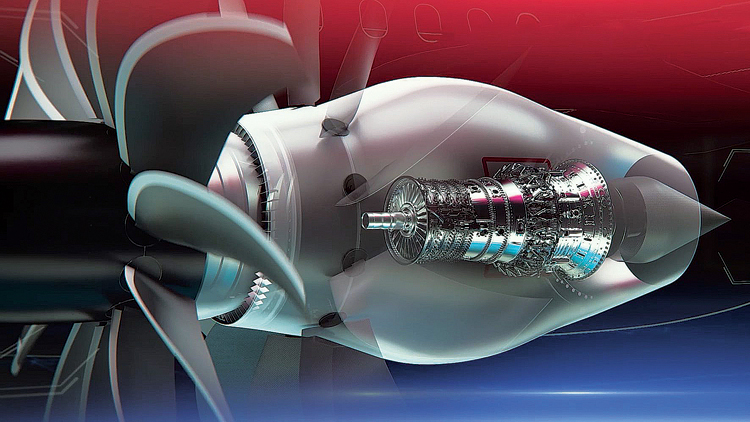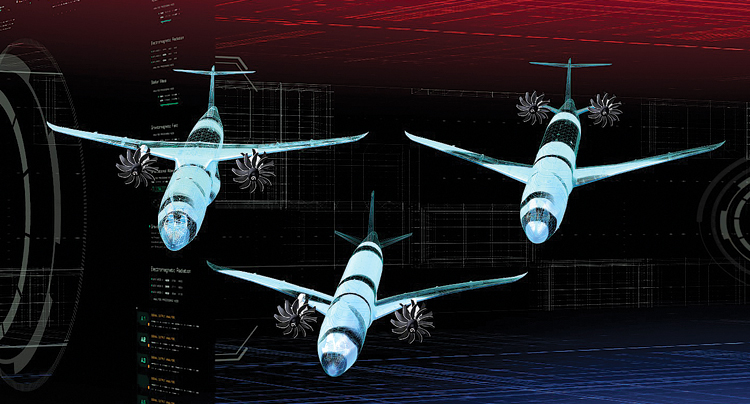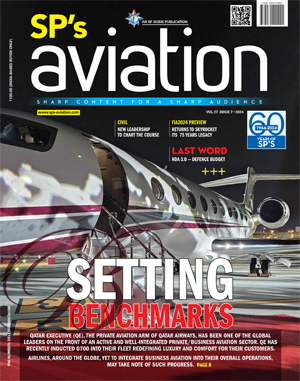INDIAN ARMED FORCES CHIEFS ON
OUR RELENTLESS AND FOCUSED PUBLISHING EFFORTS

SP Guide Publications puts forth a well compiled articulation of issues, pursuits and accomplishments of the Indian Army, over the years

I am confident that SP Guide Publications would continue to inform, inspire and influence.

My compliments to SP Guide Publications for informative and credible reportage on contemporary aerospace issues over the past six decades.
CFM RISES
The CFM RISE open fan architecture is a radical innovation that seems to offer the best hope of achieving the large reduction in CO2 emissions for environment sustainability

The commercial aviation industry is under growing pressure to clean up its act on emissions. Aviation is hardly a major emitter, accounting for just 2.4 per cent of global carbon dioxide (CO2) emissions. However, its relative share of emissions is projected to at least triple by 2050 as air traffic surges and other sectors of the economy successfully decarbonise. Acutely aware of the danger of being branded a climate change “bad boy”, the industry has set its sights on achieving net-zero carbon emissions by 2050. In other words it aims to completely eliminate or at least offset its emissions by then. This ambitious goal (some would call it an impossible dream) rests on two main pillars – sustainable aviation fuels (SAF) and technological innovations, especially more fuel-efficient aircraft. SAFs produced from renewable sources can reduce carbon emissions by up to 80 per cent compared to conventional jet fuel. But they are expensive and their current production is pitifully low – around one per cent of the global jet fuel requirement.
When it comes to fuel efficiency, CFM International, a 50-50 joint venture between two of the world’s leading aerospace companies – General Electric (GE) and Safran Aircraft Engines (SAE) – has been in the forefront of technological advancement for over 40 years. Its first product, the CFM56, was a highbypass turbofan engine that entered service on April 24, 1982, and eventually became one of the most successful engines in history. However, in an effort to further improve efficiency, the LEAP engine, introduced in 2016, was 15 per cent more fuelefficient than the CFM56-5B and -7B engines. LEAP is doing exceedingly well, having logged over 25 million engine flight hours in just six and a half years of revenue service. It has left the competition far behind. Yet CFM feels the need to achieve a step change in efficiency over LEAP.
In the past, revolutionary change has been attempted only in response to rising fuel prices. When fuel prices declined there was a corresponding ebbing of enthusiasm and investment. However this time the incentive to develop more advanced technologies is that of making aviation more sustainable. This motivation can only increase given the global anxiety about impending catastrophic climate change. Enter the CFM RISE programme.
RISE ARISES
The CFM International RISE (Revolutionary Innovation for Sustainable Engines) Technology Demonstration Program was launched on June 14, 2021. Its goals include reducing fuel consumption and carbon emissions by more than 20 per cent compared to today’s most efficient engines, as well as ensuring compatibility with alternative energy sources like SAF, electricity and hydrogen. RISE is developing new technologies that can significantly reduce the environmental impact of aviation, including emissions and noise, thus making aviation more sustainable. Although RISE is only a technology demonstrator, technologies matured under its aegis will serve as the foundation for the nextgeneration CFM engine that could be available by the mid-2030s.
The RISE engine will produce around 30,000 lb of thrust, which puts it in the LEAP turbofan class. Clearly therefore CFM International’s initial focus will be the single-aisle market. But growth will probably be achievable by scaling up the fan blades and engine core.
AN OPENING FOR THE OPEN FAN
Central to the RISE programme is state-of-the-art propulsive efficiency achieved by adopting an open fan architecture. All previous efficiency breakthroughs were achieved by technologies that permitted a larger fan size and a higher bypass ratio. The larger fan required a huge fan case or nacelle to enclose it, greatly adding to the engine weight and overall drag of the aircraft. But RISE is visibly different. At one stroke, its open fan design dispenses with most of the dead weight. The fan is expected to have a diameter of around 13 feet approximating to the outer diameter of the LEAP nacelle.

RISE’s single rotating open fan design has variable pitch carbon fibre composite blades, behind which is a row of static guide vanes. On the other hand, SAE’s 2017 Sage2 demonstrator had a contra-rotating second fan stage. The original open-fan design that GE Aviation flight-tested in 1988 under its Unducted Fan (UDF) project also had a direct-drive (gearless), contra-rotating, pusher fan. But the RISE design is much simpler and lighter because stationary outlet guide vanes replace the contra-rotating fan blades. This permits flight speeds similar to that using conventional turbofan engines. Acoustics, which were a major drawback of the earlier open fan designs, are also significantly improved.
Because of their large diameter, the fan blades of the RISE open fan will need to rotate relatively slowly so that their tips don’t reach supersonic speeds. A reduction gearbox between the low-pressure spool and the fan drive shaft reduces the shaft’s rotation rate compared with that of the low-pressure turbine. Under an agreement signed in February, Airbus and CFM plan to flight-test the RISE demonstrator using an Airbus A380. The A380 will be fitted with a large support pylon and a reinforced inboard wing structure to accommodate the open fan.
Another crucial feature of CFM’s RISE is a compact engine core. In 2021, NASA awarded GE Aviation contracts to test and mature new jet engine core designs, including compressor, combustor and high-pressure turbine technologies to improve thermal efficiency.
BUILDING BLOCKS
Apart from its eye-catching open fan the RISE demonstrator will incorporate several advances in engine architecture, aerodynamics, and advanced materials that will help it achieve higher fuel efficiency and lower CO2 emissions than its predecessors. It also features technologies such as carbon fibre composites (CFC), ceramic matrix composites (CMC) and additive manufacturing.
GE Aviation and CFM International are the only engine manufacturers with CFC blades in commercial service. These fan blades are higher strength and lighter weight than the titanium fan blades they have replaced. Similarly CMCs, another advanced composite material containing silicon carbide fibres, are lighter and more heat resistant than traditional metal alloys. Engines built using CMCs can operate at higher temperatures with less cooling air. Exploiting both these technologies is additive manufacturing (also known as 3D printing) using new materials, which makes for lighter engine parts with higher capabilities and more complex designs than parts made by conventional manufacturing techniques.

RISE’s software-driven engine controls will ensure optimal fuel efficiency during each phase of flight – take-off, climb, cruise, etc. They will also monitor real-time engine health, allowing proactive resolution of emerging issues and thus improving the engine’s durability.
CFM’s RISE, from the outset, aims to reduce aviation’s environmental impact by permitting the use of 100 per cent SAF. RISE will also be capable of hybrid-electric operation, in which part of the thrust is provided by electrical power. And, most excitingly, it may be easily adaptable to run on hydrogen. Hydrogen, which is the most abundant element in the universe, produces no CO2 emissions when it burns and is therefore a potent ally in humanity’s ultimate quest to eliminate carbon emissions. Although the use of hydrogen as an aviation fuel presents daunting challenges, CFM engineers are confident that viable solutions can be found. According to GE Aviation’s CEO John Slattery, replacing conventional jet fuel completely with SAF would reduce CO2 emissions by 80 per cent. And if hydrogen were the fuel, CO2 emissions would drop to zero.
ONLY THE BEGINNING
Since the world entered the commercial jet era on May 2, 1952, with the entry into service of the de Havilland DH.106 Comet, there have not been many major advancements in jet engine technology. In fact, when the Rolls-Royce Conway, the world’s first production turbofan, entered service in the late 1950s, it attracted hardly any attention because its bypass ratio was a mere 0.3. Since then technological progress has been evolutionary rather than revolutionary with the fan diameter inching up and the bypass ratio correspondingly increasing.
However, air transport is a crucial factor in deciding whether or not the world can avert climate change. Aviation therefore can no longer count on incremental progress. A sustainable future requires a propulsion system that will dramatically increase fuel efficiency as well as meet anticipated International Civil Aviation Organization (ICAO) noise and emissions standards. The CFM RISE open fan architecture is a radical innovation that seems to offer the best hope of achieving the large reduction in CO2 emissions that aviation urgently needs to become environmentally sustainable. With its larger blades and smaller core than that of other current engines, CFM expects the RISE open fan to have an astounding bypass ratio of 75:1. This is nearly an order of magnitude greater than the 11:1 ratio achieved by the CFM LEAP-1A and the 12.5:1 ratio achieved by the Pratt & Whitney PW1100G GTF engine.
CFM International believes that the RISE technology demonstrator is only the beginning. Although RISE will feature advanced technologies tailor-made for a futuristic single-aisle aircraft propulsion system, the technology suite it develops will probably find its way into commercial aircraft of all sizes and thrust classes for decades to come.





